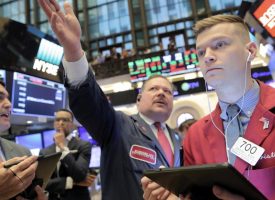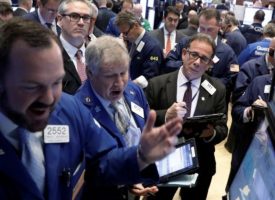Today a legend who is connected in China at the highest levels predicted the price of gold is going to hit new all-time highs.
Negative Interest Rates, Yield Negative Returns
By John Ing, Maison Placements
October 17 (King World News) – Once upon a time, saving for a rainy day meant setting aside money so that bills could be paid if one loses a job or needed for retirement. Money was even kept in mattresses because banks were considered unsafe. Today it is different. After experimenting with three rounds of quantitative easing, central banks have bought up most of the available bonds with newly printed money. Central banks from Europe and Japan have embarked on their next big experiment, negative interest rates as more than 30 central banks around the world cut interest rates this year. Negative interest rates distort markets. Swiss bankers, UBS and Credit Suisse introduced negative rates on large deposits where their wealthy clients must pay for the privilege of leaving their funds with the bank. In fact, desperate for yield, investors are buying 30-year bonds, despite the prospect of losing money at the end of term.
One concern is that the negative yields are climbing at the rate of some $3 trillion a month, growing to $17 trillion, an historic high, and soon to be joined by the United States. The rich are getting poorer. Holders of bonds today, if held to maturity are guaranteed to lose money. Another worry is that pension funds who depend on interest returns are aghast as central banks threaten to lower interest rates even more.
So what to do? If you are going to be charged to keep money in the bank, investors will buy other assets to preserve capital. To be sure, aging populations and negative yields will collide as capital allocation is distorted as debt becomes too unmanageable. Over the short term, money has been chasing overvalued stocks with a view that return on capital is better than nothing. Sometimes nothing is better than losing…
ALERT:
Mining legend Ross Beaty (Chairman Pan American Silver) is investing in a company very few people know about. To find out which company CLICK HERE OR ON THE IMAGE BELOW.
 Sponsored
Sponsored
To be sure the distortion of negative yields across the globe also hurt the central banks whose portfolios hold part of the one third of global bonds that carry negative yields. More significant is that negative yields also undermine the pension funds, banks and other savers who are the very cornerstone of the capital markets and cannot exist with negative IOUs. And Wall Street has yet to figure out how to price risk on the trillions of dollars of esoteric financial instruments because negative yields do not work in their mathematical models. The financial system has thus become not only overly exposed but also unsustainable as weaker companies, unprofitable or leveraged players pile up more “interest free” debt. Debt cannot keep rising while interest rates keep falling. Eventually, central banks will reach a negative rate floor when cash in the system runs out or when depositors withdraw funds as they decline to pay fees to lend to those institutions. Ironically, negative interest rates have done little to boost economic growth. Central banks have become irrelevant.
Of more concern is that there is simply no reason to keep money in the bank. Taken to the absurdity, the deposit base of banks will inevitably shrink as depositors stuff their savings into mattresses or alternatives, which reduces the banks’ original mandate, that is to make loans. Without capital for loans, loans aren’t made. But more important, negative interest rates reduces confidence in fiat currencies. History shows that when money ceases to be a store of value, investors simply find other ways to protect themselves.
Debt Does Matter
Investors and central bankers are puzzled that despite abandoning monetary orthodoxy and rounds and rounds of quantitative easing, we have declining interest rates, and inflation is nowhere to be seen. The problem is that many overlook that there is inflation, in stock prices, classic cars, precious metals, and the bond market. Money markets are behaving differently and the risk of inflation as well as central bank solvency has increased with the repo market in disarray as a sudden spike in interest rates for repurchase agreements, set the capital markets spinning.
Insert
We believe that the markets should be looking for stagflation, as a result of the huge increase in debt. Traditional economic theory is that debt monetization is a phenomenon when governments issue debt to finance spending and the central bank itself buys that debt in secondary markets, thus increasing money supply. Yet central banks are not targeting money supply but instead inflation and unemployment, which are laggard statistics and noteworthy is that unemployment
is at the lowest level in 50 years, considered full employment today. We believe that the debt monetization has come at a cost of higher debt loads. Most sovereign debt are yielding negative returns with a shift from “risk-free” returns to “return-free” risk. But, in today’s environment of declining interest rates, what remains constant is that the interest payments, are taking an increasingly larger percentage of government revenues. Those fixed interest payments on debt are deflationary and one of the reasons why there is less money going into the system which ironically was one of the factors, that exacerbated the Great Depression. Debt does matter.
Repo Market Mess, A Repeat of 2008?
And today, a decade after the last financial crisis, Wall Street is again facing a liquidity crisis as the Fed was forced to inject funds into the overnight repo market. The Fed pumped almost $300 billion into the US financial system because the system literally ran out of cash. To steady the short term money markets, the overnight borrowing rate surged more than 10 percent, up from 2 percent and upsized to $200 billion of cash for the last day of September, reflecting the tightness of the US money market. The Fed then extended purchases of Treasuries in a second attempt to avert another lending squeeze. Many viewed the repo rescue as a technical hiccup in the market’s plumbing. Wrong.
We believe the squeeze and emergency funding was a natural consequence and systemic problem of the unwinding of six years of quantitative easing, and as a result the Fed has lost its monetary grip, leading to fears that they are no longer in control of short term borrowing rates and are resorting to a soft QE4 to fix the problem. Others believe there is a larger unknown counterparty risk, particularly since the five largest US banks hold more than 90 percent of total reserves. Ironically, left unsaid is that the shortage of cash is no surprise in an environment of negative interest rates, and a familiar scene for emerging countries like Argentina where patterns of running out of cash is an all too regular event. Gold is a good thing to have as the so-called collateral chain tightens. After all, the repo market was at the epicenter of the last global financial crisis. Déjà vu.
In the Beginning, There was Gold
That is not all. The market’s daily record highs sometimes feel like a mirage. The trade wars and negative interest rates have forced investors to risk returns even though shares are overvalued. But trees don’t grow to the sky and the market is showing signs of old age. Daily highs in the Toronto market come from only a core group of stocks, while the broader sector such as the energy or financial stocks are stuck in the doldrums. Similarly, in the United States, the big technology stocks pushed the Dow to ever higher highs but the lack of breadth is concerning. More troublesome is that in the quest to boost returns in a zero rate environment, investors have sunk trillions of dollars into the largely unregulated private and venture capital markets with the big Wall Street banks stoking the bubble, fueling even higher valuations in a Ponzi-type valuation scheme.
The illusion of prosperity is best reflected by the collapse of unicorn WeWork which postponed its IPO offering, causing a backlash against big tech stocks. WeWork failed to secure the analysis of the public markets when its corporate governance and leadership concerns were disclosed. Although Wall Street’s big investment banks had valued WeWork at $65 billion, the IPO price at $47 billion was quickly discounted to $15 billion, when the deal was shelved. Scrutiny was also on the big venture capital fund, SoftBank Group who invested almost $10 billion in WeWork and like the big Wall Street banks had much to gain by the going public route. However it is not that WeWork failed because of its CEO’s foibles, but it was a flawed “growth at all cost” business model of never making any money. Of concern is that with rental commitments of $47 billion, WeWork has become the largest landlord in the world and will spend $9 billion this year, despite having cash of $6 billion It appears that SoftBank and WeWork did not hear the music stop. Caveat Emptor.
Gold Is a Better Store of Value Than the Dollar
We believe that America’s new isolation, together with the trade hostilities will usher in a cycle of competitive devaluations, stock market crashes and volatility, strikingly similar to the onset of the Great Depression in the Thirties. Governments then boosted trade barriers and rounds of protectionism caused the reneging of monetary commitments. What ended the Great Depression was a new monetary order in Bretton Woods, which lasted a quarter of a century, until replaced by a fiat currency, the US dollar and eventually, dollar hegemony. China and Russia are moving out of dollar denominated asset and buying up enormous stores of gold instead. China added almost 100 tonnes of gold to its reserves over the past 10 months. Today America has been running large, chronic deficits, spending more than they are producing, piling up the largest debt in peacetime. Like before this is unsustainable.
The US dollar acts as the primary currency for the global community and serves as the global safe-haven for international investors and official reserves. However, US financial markets are vulnerable and the epicenter of the next crisis as the United States is heavily dependent on foreign capital to finance its huge and growing deficits. In other words any reduction in foreign flows could cause Treasuries to lose value and the Fed would have to fill the financing gap. This eventuality resembles what is happening in Venezuela, Turkey, Iraq or Zimbabwe where increasing the money supply to finance consumption or pay the national debt, resulted in the debasement of currency.
So too, American profligacy and monetary hegemony has undercut faith in the dollar. America cannot have a strong economy, conduct a trade war and a weak dollar all at the same time. Gold is an alternative store of value to the dollar and until there is a replacement, it is a traditional haven asset against the debasement of currencies, giving financial protection during financial crises.
Mr. Trump is Good for Gold
Gold recently traded at 6 1/2 year highs as investors sunk almost $4 billion in September in global ETFs to 2,808 tonnes, the highest ever, amid fears of a recession, exacerbated by President Trump’s protracted tariff war as well as the onset of negative interest rates leaving investors nowhere to hide. Gold is a beneficiary of the central banks’ driven policies of negative yields. Further underpinning gold is America’s profligacy and record debt level which is not only unsustainable but undermines confidence in the US economy and its currency. One can detect the decline in confidence in every part of the world. What damages trust in the US, damages the world. Investors today are left with whom or what can they trust.
Last year 22 central banks bought the most gold in half a century ending four decades of demonetization. So far this year 14 central banks bolstered their gold reserves with total gold holdings back to early 1950 levels, with gold distribution shifting from the west to the east. Investors suspect that the American people will elect an inflationary president next year. No candidate, including Mr. Trump stands for sound money. Meantime, there are supply problems as miners deal with declining reserves, grade and increased costs. China is the largest gold producer in the world and like other major central bankers is buying gold such that China is currently the sixth largest holder, after Russia. There is not enough gold to meet demand. In June, gold broke out from a five-year trading range beginning its new bull market. Gold is up 15 percent year to date. With so much fear stalking the world, we believe gold will post new cyclical highs, exceeding the last peak of $1,921, reached in 2011.
Mr. Trump is good for gold. In the Godfather, Don Vito Corleone said, “Lawyers can steal more money with a briefcase than a thousand men with guns and masks”. Today, this” Goldfather” might have substituted politicians for lawyers. Gold is a good thing to have.
James Turk’s powerful audio interview has now been released where he discusses exactly what to look for in the gold and silver markets, mining shares, the coming crisis, the U.S. launching QE4 and much more, and you can listen to it immediately by clicking here or on the image below.
European Analyst Issues Gold Target Of $10,000
READ THIS NEXT! European Analyst Just Warned “Perfect Gold Storm Coming” – Target $10,000 CLICK HERE TO READ.
More articles to follow…
Major Update On The Gold & Silver Markets CLICK HERE TO READ.
Art Cashin – Yes, The Fed Is Engaged In QE And It Is Larger Than It Was In 2013! CLICK HERE TO READ
Gold Continues Its Correction, Fed Closes In On ECB, Plus World Economy In Trouble CLICK HERE TO READ
This Is What Is Moving Markets Today CLICK HERE TO READ
© 2019 by King World News®. All Rights Reserved. This material may not be published, broadcast, rewritten, or redistributed. However, linking directly to the articles is permitted and encouraged








